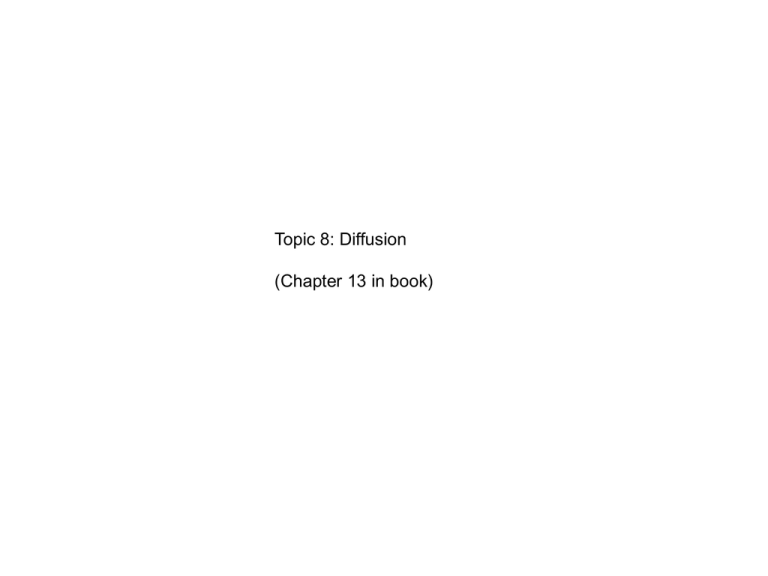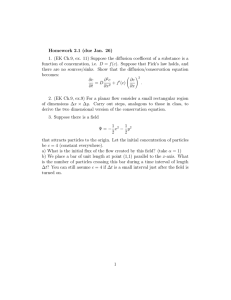Topic 8: Diffusion (Chapter 13 in book)
advertisement

Topic 8: Diffusion (Chapter 13 in book) Overview: How does thermal energy cause things to move? How do molecules spread out in time? Why do things flow when there are concentration gradients? How well can cells detect diffusing molecules in their environment? Thermal motion - diffusion When a molecule is put into a bath at a particular temperature, it gets random kicks from the thermal energy in the bath These random kicks cause it to perform a random walk This random walk is called ‘Brownian motion’ after the scientist who observed cells undergoing random motion under a microscope for small molecules, these random kicks are not small and can lead them to move rapidly and distribute uniformly this random motion generated by thermal noise is the process of diffusion Diffusion can be slow and fast In E. coli, whose size ~ microns, diffusion moves thing across the cell in less than a second. So things tend to be well mixed. In nerve cells, whose size > milimeters meters, diffusion is too slow, on the order of days, so molecular motors are used to shuttle cargo down the cell Random Walks (from ‘Random Walks in Biology’ by H. Berg Random Walks: Average Random Walks: Variance Diffusion relation: Diffusion: some #’s Or, 𝑥2 = 2𝐷𝑡 So diffusing particles, spread out as 𝑡 instead of as 𝑡 as a ballistic particle would For a small ion in water in a bacteria, time for a diffusing particle to traverse the cell is: 𝑡= <𝑥 2 > 2𝐷 = (1 𝜇𝑚)2 2 2000 𝜇𝑚2 /𝑠 ~ milliseconds so things mix fast in bacteria For a neuron with a length around 1 cm, 𝑡 = <𝑥 2 > 2𝐷 = (1 𝑐𝑚)2 2 2000 𝜇𝑚2 /𝑠 ~ 14 hours!!! so diffusion is not a good way to move material around in a neuron Random Walks: Binomial distribution At a given time, what is the distribution of x? Random Walk: Binomial Gaussian Random Walk: spreading in time So the distribution of positions for a diffusing particle, follows a Gaussian distribution spreads in time Macroscopic diffusive transport: Fick’s Equations Previously, we were looking at the statistical behaviour of single diffusing particles. Q: Can we derive an equation that will describe the dynamics of a concentration of particles diffusing in solution? Continuity Equation: Q: what is the flux of particles through the area A? flux = #/s/area 50/50 chance of moving left or right Continuity equation: continued So, 𝑗 = −𝐷 𝑑𝑐(𝑥) 𝑑𝑥 thus if there is a concentration gradient, there will be a flux of particles Particles diffuse from regions of high concentration to low. There is NO external force. It is an entropic force, that arises because there is more entropy when the system is well mixed, i.e a uniform concentration. Diffusion equation: How does the concentration change at a given location and in time given that there are fluxes in the system? Diffusion equation derivation: There are 𝑗 𝑥 𝐴 ∆𝑡 entering from left and 𝑗 𝑥 + ∆𝑥 𝐴 ∆𝑡 leaving from the right So the concentration change per unit time, 𝑐 𝑡 + ∆𝑡 − 𝑐(𝑡) 1 𝐴 ∆𝑡 =− 𝑗 𝑥 + ∆𝑥 − 𝑗 𝑥 ∆𝑡 ∆𝑡 𝐴 ∆𝑥 Or as dt and dx 0, these become derivatives, so This is a partial differential equation which in practice is hard to solve. We will just take known solutions Applications of diffusion equation: diffusion through pore Applications: Cell detecting diffusing nutrients Consider a perfectly absorbing spherical cell, Note: the diffusive current into the cell only goes as the radius of the cell and NOT the area Applications: Disc like receptor So we have the current for a i) perfectly absorbing sphere and ii) a perfectly absorbing disc-like receptor Q: What about the current for N disc-like receptors on a cell’s surface? Applications: Receptors on a cell Applications: Receptors on a cell – equivalent circuit Cell Signalling: some #’s chemotaxis receptors on surface of E. coli Summary: • Diffusing particles are carrying out a random walk • the RMS distance goes as 𝑡 • the distribution of positions of diffusing particles is a Gaussian • derived the diffusion equation • particles flow from high to low concentrations • Looked at some solutions to diffusion equation: • steady-state concentration in a chanel • absorption by spherical cell • absorption by disc-like receptor • Found that cells can detect chemical signals almost as well as having the whole cell covered with only a small % of receptors





